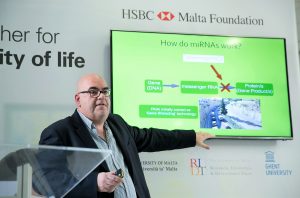A new discovery could lead to chemotherapy becoming more potent by over 50 times in three different cancers – or even leading to a reduction in the minimal dose needed to fight such cancers (allowing lower side-effects). Here, senior post-doctoral researcher DR DUNCAN AYERS explains the breakthrough.
 Imagine an asphalt truck that needs to repave a road… If the road has been cleared, then laying the asphalt will be easier; if there is an obstruction in the road, the asphalt truck can’t do its job properly.”
Imagine an asphalt truck that needs to repave a road… If the road has been cleared, then laying the asphalt will be easier; if there is an obstruction in the road, the asphalt truck can’t do its job properly.”
It’s with that analogy that Dr Duncan Ayers starts his explanation of his discovery of microRNAs (ribonucleic acid that is responsible for controlling the conversion of DNA into proteins), that could help make chemotherapy more powerful or less harmful to patients.
Building on the discovery of how microRNAs interfere in the conversion of our DNA into cell proteins by Andrew Z. Fire and Craig C. Mello (for which they won a Nobel Prize in 2006), Dr Ayers and his collaborator team in Ghent University (Belgium) now believe they are close to identifying which microRNAs would need to be tackled in order for chemotherapy to have a clear pathway to help beat breast cancer, ovarian cancer, neuroblastoma and possibly also other cancers.
“Originally the research was about neuroblastoma, a cancer which affects developing nerve tissue in children. The number of patients suffering from it is, thankfully, very low but that means that neuroblastoma research doesn’t often get funding compared to – for example – breast cancer research, so it is typically tougher to create new medicines for neuroblastoma. As a result, we worked hard to find genetic culprits for both cancers,” explains Dr Ayers, who is a senior post-doctoral researcher (RSO IV) at the Centre for Molecular Medicine and Biobanking within the University of Malta.
“Then, in 2009, I managed to eschew my research to include microRNAs thanks to technology that was made public at the time. From then, our research has shown that we are closing in on which microRNAs are detrimental to patients in certain cancers, and could be stopping chemotherapy from doing its job properly.”
Doing all this is by no means an easy feat as the number of known microRNAs has gone from 668 to 2,600 in just seven years – and, at times, some microRNAs work in combination to create this obstruction for cancer chemotherapy. Moreover, the tests required to discover which microRNAs are affecting particular processes in the body is also a complicated one.
To discover them, in fact, the researchers have to test samples of tumours for which microRNAs are present and in what levels. Then, they would need to also see if these particular microRNAs affect the way chemotherapy works on cancer cells… In fact, it is only the cure for certain kinds of cancers that could be changed and not for all.
“Based on our research and tests – and with some educated guesswork – we managed to find a combination of microRNAs that has the potential to revolutionise the way chemotherapy is administered to patients suffering from either breast cancer, ovarian cancer or neuroblastoma.
“By employing antagonists for the culprit microRNAs, in tandem with the standard amount of chemotherapy drugs needed in, for example, breast cancer, this would result in more than 52 times the standard chemotherapy drug efficacy; while doubling the amount of antagonists would actually increase this chemotherapy efficacy in an exponential manner to nearly 180 times more, with the same level of side-effects brought about by standard chemotherapy doses.”
Of course, should the research prove the combination of microRNAs to be what Dr Ayers and his collaborators hope it is, the benefits could be manifold. For starters, the reduction of the amount of chemotherapy administered to patients would mean fewer side-effects. Moreover, a normal dose of chemotherapy would become 50 to 60 times as powerful as it is today. In the long run, this could also help oncologists personalise the type and dose of chemotherapy depending on the patients and their tumour.
“At this point in time, we are still at the initial stages of testing these sequences in a lab but, once this part of the project is complete and should the results remain positive, then this will need to go through three phases of human trials to ensure that what works in theory works in practice…”
In total, this would take around five to 10 years at the very least, but the benefits could be so huge that this has not deterred the researchers. After all, this could help save hundreds of thousands of lives the world over.
“None of this hope for our research plans would be possible without the generous support of HSBC Malta Foundation, which has given us over €84,000 in funding; through key assistance by the Alive Charity Foundation, which donates funds regularly to local cancer research efforts through RIDT,” concludes Dr Ayers.
As things stand, the researchers are continuing their work with one thing in mind: the belief that they could give patients – including those children suffering from neuroblastoma – hope for a better future.
Help us fund more projects like this, as well as research in all the faculties, by donating to RIDT. Click here for more information on how to donate.
